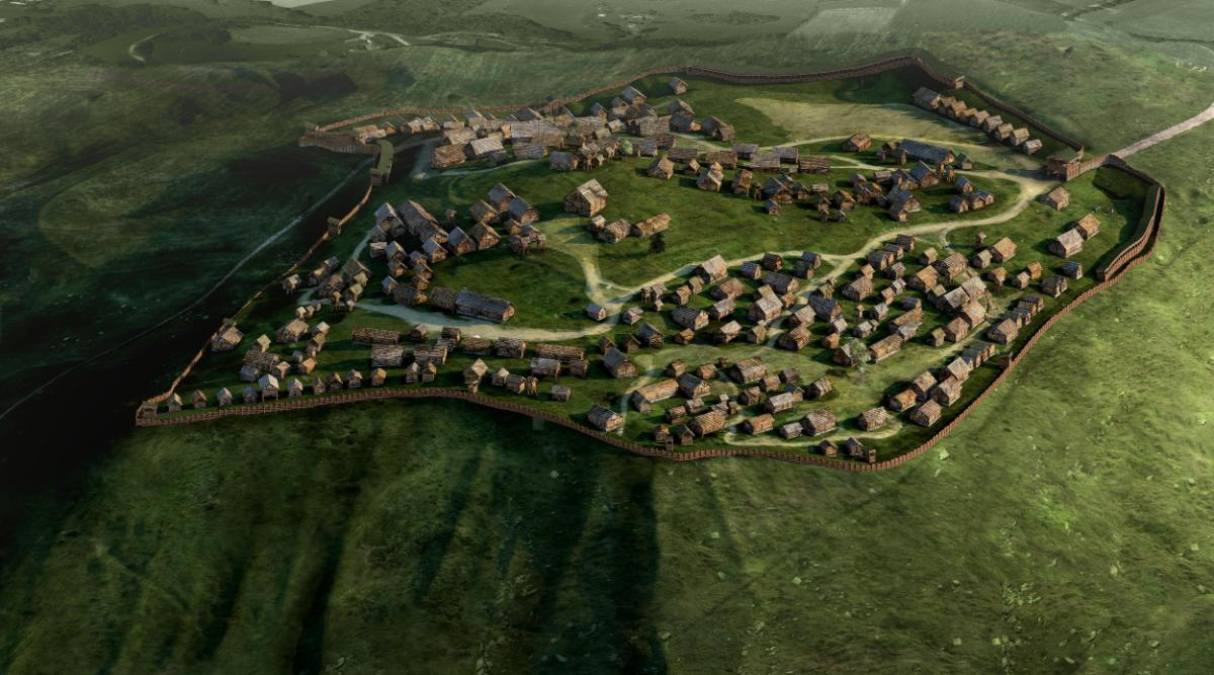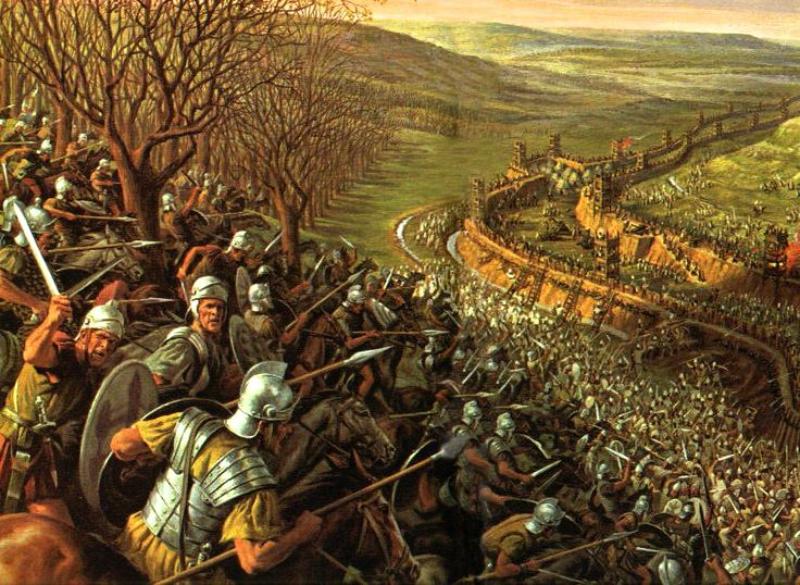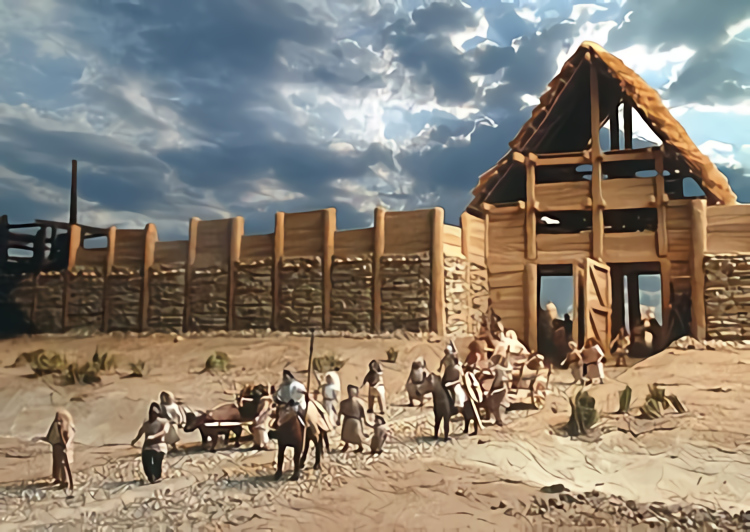The word “oppidum” (plural oppida) has its roots in Latin, and it refers to a hilltop settlement that was fortified around the end of the Iron Age and was modeled after Celtic culture. Oppidum is largely linked to the Celtic La Tène culture, which emerged in Europe during the 2nd and 1st centuries BC and expanded from Britain and Iberia in the west to the eastern margin of the Hungarian plain. The Gallic oppidum began as a small walled sanctuary used only in times of danger; over time, it evolved into a true city with commerce and the development of crafts. For the majority of the time, they occupied important locations that were placed on high ground. Some of them became the capitals of one of the several tribes that inhabited Gaul: for example, Bibracte, which was the capital of the Aedui and was located on Mount Beuvray (Morvan). During the Gallic Wars, which Julius Caesar was leading, two more fortified sites, Gergovie and Alesia, were at the center of the conflict.
More than 90 are oppida found around the world to this day. The most popular countries are Germany, France, and Belgium.
The Celts’ Migration and Subsequent Settlement of Gaul

Around the second century BC, the people who later became known as the Celts halted their migration across various areas of Europe. They established their first settlements, known as oppidum, in the region of Gaul. Some towns were the consequence of a hamlet that was relocated or transformed into another site. Others were built in places where there used to be no people at all.
Historians believe that the Cimbri and Teutons’ invasion of Gaul at the end of the second century BC and the creation of the Roman province of Narbonnaise led to the founding and growth of these settlements. Both of these events took place in the region now known as Narbonne. The first one highlighted the need to take precautions. The second one gave the Gauls the opportunity to study Roman towns before attempting to recreate them. Archaeological finds over the past few decades have shown that the founding and growth of these towns are linked to major changes in the social structure of the Gallic civilization.
The Construction of Oppidum in Gallic Lands

The Siege of Alesia in 52 BC was one of Julius Caesar‘s biggest successes. The conflict ended the Gallic Wars and Celtic control in Western Europe. The war took place in one of the most popular oppidum towns named Alesia, located in today’s France.
The oppidum towns were surrounded by fortifications made of stone and wood, and they usually covered an area that was around 1000 acres or several square kilometers. The homes have the shape of rectangles with sides of around 10 meters (33 feet). They consist of a wooden frame with clay panels attached to it and coated with clay. The streets meet at right angles to one another. The excavations of towns like Villeneuve-Saint-Germain have shed information on the specialization of some neighborhoods, such as the presence of artisans who worked with skin, textiles, or metal. Sometimes the oppidum will have an open area that will provide a safe haven for the people living in the surrounding area as well as the livestock in the event of an emergency.
Around the year 100 BC, the towns began to expand and assume an increasingly prominent role in the region. They are true strongholds since the defensive walls around them were constructed using a method that originated in Gaul. They are constructed of dry stones and have an internal structure made of wood and iron. Their length ranges from a few meters to several kilometers. The majority of the oppida are built into the terrain and are situated on higher ground. In most cases, they are situated on top of a hill that is connected to the plateau by a narrow plain in the middle. These defenses were necessary against enemies. The Roman ram was not able to break through the walls of the oppidum since they were sturdy enough.
The Function Played by the Oppidum

Given their importance, it was sufficient to capitulate the rest of the populace in the area by capturing these towns. Thus, the function of the oppida settlements was important in Caesar’s Gallic War. They were the most important settlements in a region that was mostly comprised of villages and scattered farms, and they served as the primary hubs for economic and political activity. There were other gatherings and festivals that took place there. It seems that the location of the oppidum was set by the economic role that the towns played and the need to protect themselves from the enemy. In point of fact, given their location, they were often in a position to dominate significant trade routes.
Some of these towns were prosperous as a result, such as Bibracte, which was the capital of the Aedui and served as a hub for commercial commerce with the countries of the Mediterranean. These oppida were also the sites of a considerable amount of industrial activity. The rural regions were responsible for the production of raw materials and foodstuffs, while the cities were home to skilled artisans who were able to make completed items (tools, utensils, fabrics, weapons, etc.).
Bibracte Is a Popular Gallic Oppidum
Until 1853, researchers mistakenly assumed that Bibracte, described by Julius Caesar as “the biggest and wealthiest city of the Aedui,” was the same as Autun, a city built by the Romans. On the other hand, what was once believed to be the walls of a Roman camp was later discovered to be the remnants of the ancient capital. Since that time, we have learned via archaeological digs that Bibracte was a vast urban center that was totally encompassed by ramparts that were anywhere from 5 to 6 kilometers (3–4 miles) in length.
This city served as a wonderful illustration of an oppidum. The excavations on Mount Beuvray have brought to light masonry structures that most likely belonged to wealthy Aeduan aristocrats. This is in contrast to the findings made in the other cities, where no vestiges of habitat have been identified due to the wooden constructions used in their making. This city’s prosperity may be attributed to two factors: first, its commerce with the areas around the Mediterranean, and second, the metallurgical industry that sprung up in the area.
Numerous remnants of blacksmith ovens and workshops have been discovered, in addition to a massive forge that is part of a network of workshops comprising a structure that is 80 meters (260 feet) in length.
The Evolution of Gallic Cities

Significant shifts could be seen in the structure of Celtic society as a result of the emergence of oppida at around the same time. An oligarchic system replaced the hereditary monarchy as the dominant social structure throughout time. Power was held by important aristocratic families, who were dependent on support from the vast majority of the populace. They agreed to provide their legal protection in return for the payment of taxes and the performance of military duties. When an aristocrat had more safeguards in place to protect him, he carried greater sway in society and was more persuasive in legal proceedings. Because of their privileged status, these families were able to exert influence on the religious, political, and economic aspects of Gallic culture.
The development of a Gallic cavalry and the disappearance of necropolises with burial grounds next to an oppidum are two additional significant shifts that are visible to the naked eye. At the same time that these communities were established, a cavalry that would remain in existence permanently was formed, in contrast to the past, when soldiers were only mustered on an as-needed basis. These new soldiers put quite a lot of time and effort into their training, and they chose a career in combat. They battled either for their city or for wealthy aristocrats who employed them. They carried long swords and defended themselves with helmets, shields, and even chain mail at times. Their predecessors were not as well prepared as they were.
Because there is no evidence of graves in the area around these urban sites, it is hypothesized that the locals were incinerated and their ashes were buried instead of being laid to rest. This change happened at the same time as the first oppidum was built. This is more physical evidence that the oppidum was made in response to a major change in Celtic culture.
Following the Roman invasion, the majority of the oppida were demolished to make way for the construction of brand new towns that were situated on plains or near rivers.
Bibliography
- Oppida: A European Civilization – An international project by Culture 2000
- John Collis, The Celtic World, (1995).
- Digital reconstruction of the Staffelberg oppidum.


